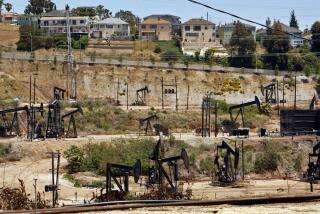FIRE IN THE OIL FIELDS
The oil fields of Kuwait are ablaze with more than 50 fires, ignited by Iraqi forces in an effort to conceal their troop movements, or by allied bombs raining havoc on enemy positions. Many of the remainder of the country’s wells--numbering more than 1,000--are likely to be blown up by Iraqi troops, making good on Saddam Hussein’s threat to destroy Kuwait’s wells and refineries. Whatever the cause, many of the fires will burn unchecked for the duration of the war. Here is a look at what weapons firefighters will bring to their battle with flame and smoke.
FIREFIGHTING WEAPONS Water
Used to cool tanks that aren’t burning
A powerful stream of water can “blow” out a wellhead fire
Like a heavy rain, a broad arc of water protects firefighters, enabling them get near enough to shut off a valve or set an explosive charge.
Explosives
A medium-size charge of dynamite is placed near the well. When it explodes, it’s like blowing out a birthday candle. Firefighters must be able to get near enough to well head source to place a charge
Foam
A layer spread on top of a well-confined fire, such as a storage tank, smothers it. The oil can then be drained from the lower part of the tank.
POTENTIAL PROBLEMS
The wells are likely to be booby-trapped, endangering crews attempting to put out the fires.
The longer the fires burn, the harder they are to extinguish because the wellheads erode.
Burning storage tanks are subject to “boil overs”--the disastrous result of fiery oil hitting any water that may have pooled at the bottom of the tank. This could spread fire to adjacent tanks. Some of Kuwait’s crude oil is known to have a high sulfur content, which could produce toxic fumes when burned.
HOW LONG WILL THEY BURN?
If oil is flowing freely from a wellhead under natural pressure and ignites, it could burn for months.
If oil has to be pumped from a well, it is more likely to burn itself out because the oil won’t be brought to the surface. Whatever pumps haven’t been destroyed can be shut off once technicians are allowed in.
Debris from the oil-bearing sands below the well might plug the well, shutting off the oil.
Since they contain a limited amount of oil, storage tanks can burn themselves out in several days or weeks.
FIRES AND THE ENVIRONMENT
Oilwell fires produce comparatively little smoke because they burn efficiently--much like a Bunsen burner in a chemistry lab.
Burning storage tanks produce large volumes of smoke but the fires burn themselves out comparatively quickly.
The massive volumes of smoke pumped into the air by oil fires is not expected to have an effect on global weather. Most scientists agree that the heavy soot will not soar high enough into the atmosphere to allow it to be spread around the world.
On a regional level, though, there are some serious environmental effects. For example, “black rain”--a mixture of natural precipitation and soot from the Kuwait oil fires--has been reported falling on the Iran-Kuwait frontier. The runoff can pollute water resources. Morever, refugees from Kuwait city have described the oily, sooty residue covering everything and say that the smoke made breathing difficult.
Sources: Los Angeles Times; Financial Times of London; Engineering News-Record; United Press International; University of Nevada, Reno; American Petroleum Institute; Oil & Gas Journal.
More to Read
Sign up for Essential California
The most important California stories and recommendations in your inbox every morning.
You may occasionally receive promotional content from the Los Angeles Times.








